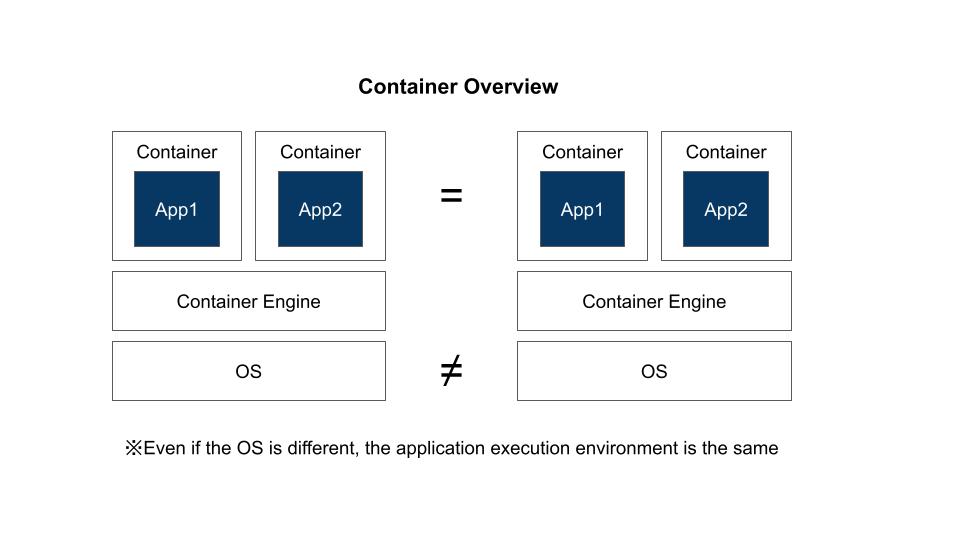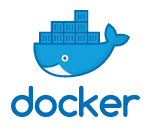1. Introduction
Hello! We are a writer team from Definer Inc.
In this issue, you are wondering why are containers used in good services.
Let's take a look at the actual screens and resources to explain in detail.
2. Always configure the same environment, independent of the server
Have you ever experienced the following?
A file can be opened on Mr. A's PC, but not on Mr. B's PC.
A program works on Mr. C's PC, but not on Mr. D's PC.
In the development field, technologies such as containers and virtualization are used to avoid such problems.
(We will not discuss virtualization this time, but will explain containers below.)
Containers have been widely used in recent years because they are lighter, faster, and more resource efficient than virtualization.
The use of containers is increasing every year, with the number of companies deploying them in production environments increasing from 3.7% in 2016 to 14.2% in 2020, more than four times the rate four years later.
3. Container Overview
A container is a technology that isolates the resources it uses from other processes and runs applications within it.
As a result, the application on the container appears to be running on an independent computer.
This makes it easy to reproduce the same environment even if servers have different OS types and versions.
 As an image, imagine a container used for logistics.
No matter what kind of truck or ship it is being transported in, the cargo inside the container is essentially independent and unaffected by other cargo or transportation methods.
(Technically, humidity and temperature might affect it, though.)
As an image, imagine a container used for logistics.
No matter what kind of truck or ship it is being transported in, the cargo inside the container is essentially independent and unaffected by other cargo or transportation methods.
(Technically, humidity and temperature might affect it, though.)
 For IT containers, it is also like separating the application space from the OS.
Because of this, the same environment can be reproduced on different servers.
The most representative technology for containers is Docker.
Docker is open source software (OSS) and is managed by Docker Inc.
For IT containers, it is also like separating the application space from the OS.
Because of this, the same environment can be reproduced on different servers.
The most representative technology for containers is Docker.
Docker is open source software (OSS) and is managed by Docker Inc.

 As an image, imagine a container used for logistics.
No matter what kind of truck or ship it is being transported in, the cargo inside the container is essentially independent and unaffected by other cargo or transportation methods.
(Technically, humidity and temperature might affect it, though.)
As an image, imagine a container used for logistics.
No matter what kind of truck or ship it is being transported in, the cargo inside the container is essentially independent and unaffected by other cargo or transportation methods.
(Technically, humidity and temperature might affect it, though.)
 For IT containers, it is also like separating the application space from the OS.
Because of this, the same environment can be reproduced on different servers.
The most representative technology for containers is Docker.
Docker is open source software (OSS) and is managed by Docker Inc.
For IT containers, it is also like separating the application space from the OS.
Because of this, the same environment can be reproduced on different servers.
The most representative technology for containers is Docker.
Docker is open source software (OSS) and is managed by Docker Inc.

4. Advantages of Containers
The advantages of containers are described below.
 Lightweight and speedy
Because containers are lightweight, they are much faster to start up.
They also consume fewer resources, giving them a cost advantage.
Lightweight and speedy
Because containers are lightweight, they are much faster to start up.
They also consume fewer resources, giving them a cost advantage.
 Easy to unify environments
The same environment can be easily built in a few steps.
Docker images can be distributed as packages, allowing for efficient environment unification.
Easy to unify environments
The same environment can be easily built in a few steps.
Docker images can be distributed as packages, allowing for efficient environment unification.
 Easy to Scrap & Build
Containers are disposable execution environments, and a new environment can be rebuilt each time.
This allows for continuous verification and faster development.
There are no major disadvantages to container deployment, but it should be noted that it is necessary to secure and train engineers who understand containers.
Easy to Scrap & Build
Containers are disposable execution environments, and a new environment can be rebuilt each time.
This allows for continuous verification and faster development.
There are no major disadvantages to container deployment, but it should be noted that it is necessary to secure and train engineers who understand containers.
 Lightweight and speedy
Because containers are lightweight, they are much faster to start up.
They also consume fewer resources, giving them a cost advantage.
Lightweight and speedy
Because containers are lightweight, they are much faster to start up.
They also consume fewer resources, giving them a cost advantage.
 Easy to unify environments
The same environment can be easily built in a few steps.
Docker images can be distributed as packages, allowing for efficient environment unification.
Easy to unify environments
The same environment can be easily built in a few steps.
Docker images can be distributed as packages, allowing for efficient environment unification.
 Easy to Scrap & Build
Containers are disposable execution environments, and a new environment can be rebuilt each time.
This allows for continuous verification and faster development.
There are no major disadvantages to container deployment, but it should be noted that it is necessary to secure and train engineers who understand containers.
Easy to Scrap & Build
Containers are disposable execution environments, and a new environment can be rebuilt each time.
This allows for continuous verification and faster development.
There are no major disadvantages to container deployment, but it should be noted that it is necessary to secure and train engineers who understand containers. 5. Minimum things to remember when starting a container
The following are important concepts to get you started with containers.
 Docker image
This is a template that contains OS and application information in a container.
Many Docker images are available for CentOS and Ubuntu, which are the most commonly used operating systems in development, as well as their major middleware.
Docker image
This is a template that contains OS and application information in a container.
Many Docker images are available for CentOS and Ubuntu, which are the most commonly used operating systems in development, as well as their major middleware.
 Dockerfile
This is the definition of the container that contains the Docker image.
In addition to the Docker image, it defines the software to be installed and the commands to be executed.
Dockerfile
This is the definition of the container that contains the Docker image.
In addition to the Docker image, it defines the software to be installed and the commands to be executed.
 Docker image
This is a template that contains OS and application information in a container.
Many Docker images are available for CentOS and Ubuntu, which are the most commonly used operating systems in development, as well as their major middleware.
Docker image
This is a template that contains OS and application information in a container.
Many Docker images are available for CentOS and Ubuntu, which are the most commonly used operating systems in development, as well as their major middleware.
 Dockerfile
This is the definition of the container that contains the Docker image.
In addition to the Docker image, it defines the software to be installed and the commands to be executed.
Dockerfile
This is the definition of the container that contains the Docker image.
In addition to the Docker image, it defines the software to be installed and the commands to be executed. 6. Summary
This article summarizes the contents of this article.
 Containers are a technology that isolates the resources used from other processes and executes applications within them.
Containers are a technology that isolates the resources used from other processes and executes applications within them.
 Applications on containers appear to run on independent computers, and the same environment can be reproduced even on servers with different operating systems, etc.
Applications on containers appear to run on independent computers, and the same environment can be reproduced even on servers with different operating systems, etc.
 The advantages of containers are (1) lightweight and speedy, (2) easy unification of environments, and (3) easy scrap-and-build.
We encourage you to try containers with docker.
The advantages of containers are (1) lightweight and speedy, (2) easy unification of environments, and (3) easy scrap-and-build.
We encourage you to try containers with docker.
 Containers are a technology that isolates the resources used from other processes and executes applications within them.
Containers are a technology that isolates the resources used from other processes and executes applications within them.
 Applications on containers appear to run on independent computers, and the same environment can be reproduced even on servers with different operating systems, etc.
Applications on containers appear to run on independent computers, and the same environment can be reproduced even on servers with different operating systems, etc.
 The advantages of containers are (1) lightweight and speedy, (2) easy unification of environments, and (3) easy scrap-and-build.
We encourage you to try containers with docker.
The advantages of containers are (1) lightweight and speedy, (2) easy unification of environments, and (3) easy scrap-and-build.
We encourage you to try containers with docker. 7. Citation/Reference
 IDC 2021 User Adoption Survey on Containers/Kubernetes in Japan Released
IDC 2021 User Adoption Survey on Containers/Kubernetes in Japan Released
 AWS What is Docker?
AWS What is Docker?
 IT Media The percentage of Japanese companies using containers in production environments has increased significantly, and the reasons for adoption are
IT Media The percentage of Japanese companies using containers in production environments has increased significantly, and the reasons for adoption are
 SBBIT What are containers, how are they different from traditional virtualization, and what are Docker and Kubernetes?
SBBIT What are containers, how are they different from traditional virtualization, and what are Docker and Kubernetes? 8. About the proprietary solution "PrismScaler"
✅ PrismScaler is a web service that enables multi-cloud infrastructure construction such as AWS, Azure, and GCP in just 3 steps, without requiring development and operation.
✅ It is a solution that streamlines "automatic construction," "automatic monitoring," "problem detection," and "configuration visualization" related to cloud infrastructures, and takes over the tedious and difficult tasks performed by cloud engineers and SRE/DevOps engineers.
✅ It is intended for a wide range of usage scenarios such as cloud infrastructure construction/cloud migration, cloud maintenance and operation, and cost optimization, and can easily realize more than several hundred high-quality general-purpose cloud infrastructures by appropriately combining IaaS and PaaS.
9. Contact us
In "[Introduction to AWS] Gathering Server Information with AWS Application Discovery Service - PrismScaler", useful introductory information is available free of charge.
For consultation and inquiries, please contact "Definer, Inc.
10. Regarding Definer.
 Definer Inc provides one-stop solutions from upstream to downstream IT.
Definer Inc provides one-stop solutions from upstream to downstream IT.
 We are committed to providing integrated support for advanced IT technologies such as AI and cloud IT infrastructure, from consulting to requirements definition / design development / implementation, and maintenance and operation.
We are committed to providing integrated support for advanced IT technologies such as AI and cloud IT infrastructure, from consulting to requirements definition / design development / implementation, and maintenance and operation.
 Through DevOps and CI/CD consulting, we realize "creating a mechanism for business growth with fewer engineers," "creating an environment where engineers are happy and easy to hire," and "a fast agile development environment.
Through DevOps and CI/CD consulting, we realize "creating a mechanism for business growth with fewer engineers," "creating an environment where engineers are happy and easy to hire," and "a fast agile development environment.
 PrismScaler is a high-quality, rapid, "auto-configuration," "auto-monitoring," "problem detection," and "configuration visualization" for multi-cloud/IT infrastructure such as AWS, Azure, and GCP.
©️ Definer Inc. All rights reserved.
PrismScaler is a high-quality, rapid, "auto-configuration," "auto-monitoring," "problem detection," and "configuration visualization" for multi-cloud/IT infrastructure such as AWS, Azure, and GCP.
©️ Definer Inc. All rights reserved. 
